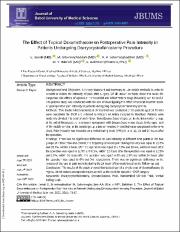| dc.contributor.author | Jamali, S | en_US |
| dc.contributor.author | Sabermoghaddam, M | en_US |
| dc.contributor.author | Sabermoghaddam, AA | en_US |
| dc.contributor.author | Kiarudi, MY | en_US |
| dc.contributor.author | Bakhtiari, E | en_US |
| dc.date.accessioned | 1401-12-09T23:22:00Z | fa_IR |
| dc.date.accessioned | 2023-02-28T23:22:00Z | |
| dc.date.available | 1401-12-09T23:22:00Z | fa_IR |
| dc.date.available | 2023-02-28T23:22:00Z | |
| dc.date.issued | 2023-03-01 | en_US |
| dc.date.issued | 1401-12-10 | fa_IR |
| dc.identifier.citation | (1401). مجله علمی دانشگاه علوم پزشکی بابل, 25(1), 78-87. | fa_IR |
| dc.identifier.issn | 1561-4107 | |
| dc.identifier.issn | 2251-7170 | |
| dc.identifier.uri | http://jbums.org/article-1-10727-en.html | |
| dc.identifier.uri | https://iranjournals.nlai.ir/handle/123456789/941218 | |
| dc.description.abstract | Background and Objective: It is very important and necessary to use certain methods in order to prevent or reduce the intensity of pain after surgery. Of all known methods, those that avoid the dangerous side effects of opioids or nonsteroidal anti-inflammatory drugs (NSAIDs) can be useful. The present study was conducted with the aim of investigating the effect of topical dexamethasone on postoperative pain intensity in patients undergoing dacryocystorhinostomy (DCR).
Methods: This double-blind randomized clinical trial was conducted on 80 patients aged 18-75 who were candidates for DCR and referred to Khatam Al-Anbia Hospital in Mashhad. Patients were randomly divided into control and intervention (dexamethasone) groups. In the intervention group, at the end of the procedure, a tampon impregnated with dexamethasone was placed in the upper part of the middle concha. In the control group, a tampon washed in distilled water was placed in the same place. Pain intensity was recorded on a verbal rating scale (VRS) 0, 3, 6, 12, 18 and 24 hours after the operation.
Findings: There was no significant difference in pain intensity at different time points in the two groups of intervention and control; the frequency of severe pain during recovery was equal to 22.5% and 15.7%, within 3 hours after the operation was equal to 17.5% and 10.0%, within 6 hours after the operation was equal to 12.5% and 0.5%, within 12 hours after the operation was equal to 12.5% and 2.5%, within 18 hours after the operation was equal to 0% and 2.5% and within 24 hours after the operation was equal to 0% and 0%, respectively. There was no significant difference in the process of changes in pain intensity during the 24 hours of the study based on the follow-up test.
Conclusion: The results of the study showed that topical use of a single dose of dexamethasone (8 mg) could not reduce postoperative pain as well as the need for opioids in DCR surgery. | en_US |
| dc.format.extent | 434 | |
| dc.format.mimetype | application/pdf | |
| dc.language | English | |
| dc.language.iso | en_US | |
| dc.publisher | دانشگاه علوم پزشکی بابل | fa_IR |
| dc.relation.ispartof | مجله علمی دانشگاه علوم پزشکی بابل | fa_IR |
| dc.relation.ispartof | Journal of Babol University Of Medical Sciences | en_US |
| dc.subject | Dacryocystorhinostomy | en_US |
| dc.subject | Dexamethasone | en_US |
| dc.subject | Pain | en_US |
| dc.subject | Randomized Clinical Trial | en_US |
| dc.subject | Verbal Rating Scale. | en_US |
| dc.subject | surgery | en_US |
| dc.title | The Effect of Topical Dexamethasone on Postoperative Pain Intensity in Patients Undergoing Dacryocystorhinostomy Procedure | en_US |
| dc.type | Text | en_US |
| dc.type | Research | en_US |
| dc.contributor.department | 1.Eye Research Center, Mashhad University of Medical Sciences, Mashhad, I.R.Iran. | en_US |
| dc.contributor.department | 2.Department of Anesthesiology, Faculty of Medicine, Mashhad University of Medical Sciences, Mashhad, I.R.Iran. | en_US |
| dc.contributor.department | 1.Eye Research Center, Mashhad University of Medical Sciences, Mashhad, I.R.Iran. | en_US |
| dc.contributor.department | 1.Eye Research Center, Mashhad University of Medical Sciences, Mashhad, I.R.Iran. | en_US |
| dc.contributor.department | 1.Eye Research Center, Mashhad University of Medical Sciences, Mashhad, I.R.Iran. | en_US |
| dc.citation.volume | 25 | |
| dc.citation.issue | 1 | |
| dc.citation.spage | 78 | |
| dc.citation.epage | 87 | |





